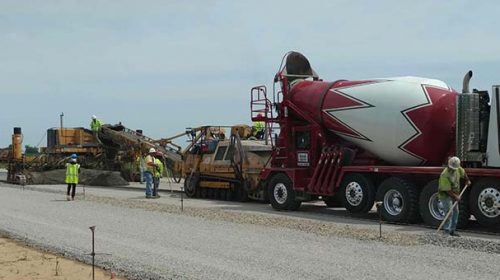The American Concrete Pavement Association has once again played a key role in advancing a Federal Aviation Administration-backed research and technology program for airfield pavements. “Our long-term goal is to secure funding for the collaborative research for each of the five years authorized for the program in the FAA Bill,” says ACPA CEO Gerald Voigt, P.E. “Thus far, additional funding has been secured for the ‘Airfield Pavement Technology Program’ in the ‘minibus’ funding package, which was signed into law by President Trump in December 2019. The measure provides funding for FY 2020.
|
|
| Delphi (Ind.) Municipal Airport Runway 18-36 Extension; 2019 ACPA Excellence in Concrete Pavement Award, Reliever & General Aviation Airports. |
 |
| The American Concrete Pavement Association promotes best practices through government affairs channels and its annual Excellence in Concrete Pavements Awards program. Shown here is the new Runway 5-23 at Grand Strand Airport in North Myrtle Beach, S.C. A 7.5-in. unbonded concrete slab on asphalt, the project earned Hi-Way Paving Inc. Gold recognition in the Overlays (Airports) category. |
 |
“Given the large investments made in airfield pavement infrastructure, we worked closely with legislators to champion a provision that ensures an appropriate investment is made in advancing new pavement technology for commercial airfields.”
Groundwork began two years ago when ACPA Executive Vice President Leif Wathne and Vice President of Airports and Technology Gary Mitchell teamed with Portland Cement Association and National Asphalt Pavement Association peers on language for pavement technology implementation in the FAA Reauthorization Act of 2018. The bill includes language establishing “Research and Deployment of Certain Airfield Pavement Technologies,” a program centered on safer, more cost effective and durable aviation infrastructure.
With the authorization secured in 2018, ACPA, PCA and NAPA focused on appropriations in 2019. The important next step was to secure an additional $6 million in funding over the $33.2 million baseline amount for Airport Technology Research, to be applied to the new research and deployment undertaking.
“Last year, ACPA’s government affairs staff, working with PCA and NAPA secured funding for that program in the FY 2020 DOT appropriations bill. In the second week of this year, we held meetings with senior FAA officials, and set a positive tone and direction for developing the collaborative research program, as well as for prioritizing topics,” notes Voigt. “Although agency-industry priorities still need to be worked out, ACPA and our technology partners are well-prepared to support a collaborative effort with FAA.”
SPECIFICATIONS MILESTONE
ACPA has collaborated with the agency on other key initiatives. “For many years, we have enjoyed a productive working relationship with the Federal Aviation Administration, including officials from both FAA Headquarters in Washington, D.C., and the William J. Hughes Technical Center in Atlantic City, N.J.,” Voigt explains. “One example of our effective agency/industry collaboration can be seen in our large-scale effort to work with the agency on Advisory Circular 150/5370-10H, Standard Specifications for Construction of Airports.”
ACPA VP Mitchell and Airport Task Force worked with the FAA to revise the specifications starting in 2017, culminating in last year’s release of the current 150/5370-10H document. “The entire range of construction specifications was examined during our Airfield Task Force’s review and revision process, including specifications for concrete pavement construction (P-501), aggregate base course (P-209), cement-treated base course (P-304) and other provisions,” observes Voigt. “The new standard provides better assurance of a quality pavement to FAA, clear language and a more constructible standard for our contractor members.”
LEVERAGING PAST SUCCESSES
ACPA cites a precedent for a cooperative agency/industry program—one developed 20 years ago that produced many concrete pavement design and construction best practices and resources that are still used for airfield construction today.
“In 2000, ACPA successfully advocated for the first-ever airport pavement research provision that was included in Federal surface transportation legislation,” Voigt says, noting language in AIR-21 or the Wendell H. Ford Aviation Investment and Reform Act for the 21st Century. “The concrete pavement community collaborated with the FAA and that first-ever program of its type yielded 40 prioritized and impactful projects valued at about $12.5 million. In all, we saw six advisory circulars, which provide guidance on meeting FAA regulations, along with resources that profoundly changed how concrete pavements were designed and constructed for airports.”
“The airfield pavement technology program is patterned after a successful highway-related program ACPA developed and championed, which also was a similarly combined effort with PCA and NAPA,” he adds.
Known as the Accelerated Implementation and Deployment of Pavement Technologies or AID-PT program, the concrete aspect has been administered by the Federal Highway Administration with advisory input from ACPA and the National Concrete Pavement Technology Center.
“AID-PT on the highway side has resulted in advancements of concrete overlay and precast panel technology, development of performance-engineered mixtures technology, technical assistance to dozens of state highway agencies, and the development and distribution of scores of training publications and resources benefitting concrete paving programs at the state level,” says Voigt. The AID-PT program was first included in the MAP-21 or the Moving Ahead for Progress in the 21st Century Act in 2012, then again in the FAST Act or Fixing America’s Surface Transportation Act in 2015. The latter authorizes the program through the current FY2020.
